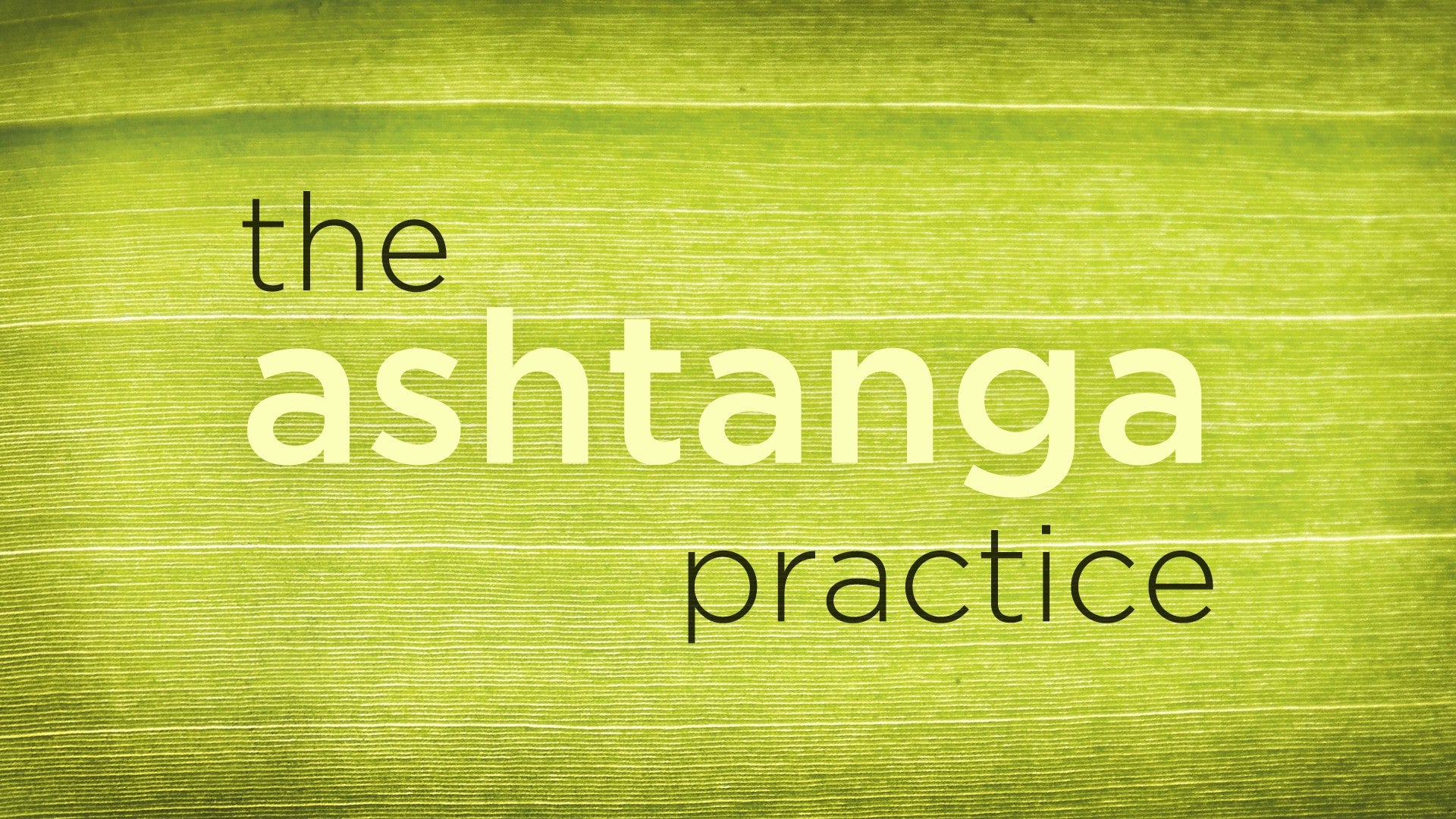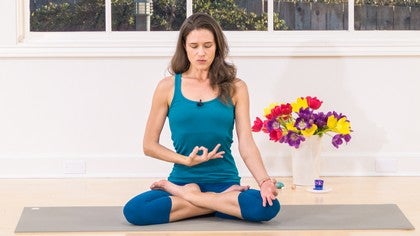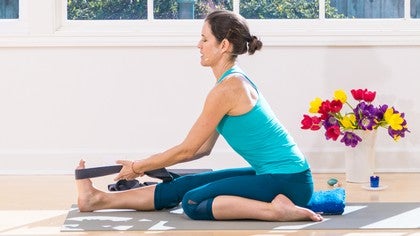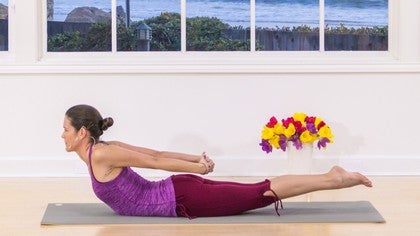Description
About This Video
Transcript
Read Full Transcript
(waves crashing) Hello, and welcome back. So excited to share a few Pranayama exercises with you. More recently fallen in love with Pranayama as it supports and serves the practice and meditation. And, sometimes on days when I just don't have the physical energy for a physical Asana practice, Pranayama can be incredibly powerful. So, I'm just gonna give you a few, a few different exercises and we'll work with a little bit instructional participate together.
These wouldn't necessarily all be done in conjunction with one another, but I wanna offer them all to you and then you can choose, depending on your energy on any given day, which one you might wanna work with. Okay? SO, we'll start really simply with Ujjayi breath, which is the foundational breath for the Ashtanga practice. And also for Vinyasa. Believe it or not.
Sometimes it gets lost, but it should be there. So, Ujjayi means victorious, and if you've done any Ujjayi breathing, you can certainly relate to that. It's a really invigorating, energizing, empowering breath. The idea is to circulate more energy and oxygen throughout the body. And also, ideally, once the breath is a little bit more developed, and becomes slightly audible in a quiet room, then it becomes a point of meditation for the mind.
So, you'll notice if you're in the midst of your practice and you're starting to kind of drift off and lose focus, you can come back to the sound of your breath. So, a basic tenants of Ujjayi breathing, you want the tongue kind of sitting at the bottom of the mouth and the tip of the tongue lifting right behind the top teeth. All right, so you're kind of making this cavern with the mouth and then you're lifting the soft palette ever so slightly at the back of the throat, creating a really hollow, vibrational space through the throat for the sound of the breath. All right? And it sounds a little bit like this.
(breathing) All right, like the waves of the ocean, or Darth Vader. The idea is to keep that really deep, full, intentional breath without tensing, without clenching. All right, sometimes when we're new to it, the shoulders go up around the ears, and the body gets really tense and tight. Totally antithetical to what we're trying to create. So, it is a really deep, full, intentional breath, but, as much as possible, we wanna keep the rest of the body just relaxed and still.
Okay? So, typically, this is done in conjunction with the Asana practice, but if you're ever just feeling a little bit off-center, or agitated, or tired, or weary, you can just find a quiet space, at work, at home, wherever you may be, take a comfortable seat, let your hands rest. It's really nice to take the thumb and the first finger together, for Pranayama exercises, to keep the energy circulating throughout the body. And then take a steady gaze. And let's breathe for a couple of minutes together.
Big inhale through the nose. Exhale out through the nose. Filling up, big inhale. Expanding through the lungs and the diaphragm. And exhale.
All the breath out. Again, inhaling. And exhale. Let's stay with this breath together. (breathing) And then just gently let the hands relax.
Let 'em rest wherever they're most comfortable. Let your breath be organic again. Just completely effortless, whatever naturally occurs. Keep the gaze soft and steady, and just take a moment or so here to feel the effect of just a couple minutes of intentional Ujjayi breath. (breathing) Good, so again, anytime you wanna center, or anytime you wanna reconnect and ground, you can do that while you're waiting in line at the grocery store, or while you're driving the car.
Anytime at all. Just a really deep, full, intentional breath. It gets you back in touch with your own center and prepares you for the practice. All right? From here, we'll shift into a Kapalabhati breath.
So, Kapalabhati breath is the breath of fire. Different energy here. You're really kind of stoking the fire, building energy, heat, Tapas. Ideally, if possible, you're in a nice, strong cross-legged position. Maybe even full lotus, if that's comfortable for your body.
If not, don't worry about it. And, if sitting upright in a comfortable position doesn't work as is, please feel free to slide a bolster or blanket underneath the sit bones. That can be really grounding and supportive for Pranayama. And then, very important in Kapalabhati, to have that thumb and first finger connection. And very important in all Pranayama, to keep the spine nice and tall so that central channel, Sushumna Nadi, is really vibrant and aligned.
Part of what we're doing with Pranayama exercise is intentionally cultivating energy. So, in order to let that energy rise, we need the central channel to be upright. All right, of course, if you're slumped, or off center, it's a little harder for the energy to find that channel. Okay? Before we begin, I just want to say, no Kapalabhati if you're pregnant or think you might be be pregnant, okay?
Don't need to stoke the heat anymore. All right, so, basic instruction here, thumb and first finger touch, palms are facing up. In a moment we'll close the eyes and if possible, you're gonna internally lift the gaze up towards the third eye. So, in the yoga tradition, this is known as the door of perception and intuition. So, you wanna draw the energy there as we're cultivating the breath.
And then, you'll exhale empty all the breath out sip just a little air in and then take very rapid breaths. The emphasis is all on the exhale. The inhale happens organically. The body just needs air, so it'll take it and then you exhale, force it out. And I love the word force, but there is definitely an energetic press to get the air out.
All right? If this makes you dizzy or lightheaded, or anxious in anyway, just back off, find a steady breath. Maybe return to Ujjayi, whatever feels comfortable. Okay? So, hands at rest.
Eyes closed. Spine tall. Internally lift the gaze up towards the third eye. Exhale all the breath out. Inhale sip just a little air in, and begin.
(breathing rapidly) Then exhale empty all the breath out. Together, take a really big inhale. Hold the breath in, lift the deep lower belly, drop the chin, hold. Lift the chin, open the mouth, exhale. Two more rounds.
Sip a little air in, and begin. (breathing rapidly) Exhale, empty it all out. Together, big inhale. Hold the breath in at the top. Lift the deep lower belly, drop the chin, hold.
Lift the chin, open the mouth, exhale. For the last round, please feel free to speed it up, or slow it down. Just focus on the contraction of the diaphragm with each exhale, and the natural, organic inhale. So, empty the breath out again. Sip a little air in, and begin.
(breathing rapidly) Exhale it all out. Really big inhale. Fill it all the way up. Pull the breath in, slight drop of the chin, keep the shoulders soft, hold. Lift the chin, open the mouth, exhale.
Keep the eyes closed. Return to an organic breath. And notice any shift in energy and vibration. Very, very stimulating, energizing, heating, and warming breath. If you're feeling really fatigued, or sluggish, or congested, or you just need to warm the body before a practice, Kapalabhati is amazing, amazing support.
Just resting in the breath for another moment or two. (breathing) And, as you're ready let the eyes open. Gently come back into the space. And the third and final Pranayama exercise we'll work with today is alternate nostril breathing, or Nadi Shodhana. Complete other end of the spectrum from Kapalabhati.
This is a really, really, peaceful, balancing, grounding, breath. So, the intention really is to draw the left and right hemispheres of the brain into balance in the left and right sides of the body. To bring the whole system into equilibrium and harmony. Okay? So, it can be done with a little pause at the top of the inhale and the bottom of the exhale.
We won't do that for today. We'll just work with an even inhale, even exhale for a few cycles. Okay? So I'll talk you through it to begin. The left hand is at rest.
The thumb and first finger draw to touch. The right hand is gonna be near the face. The first two fingers can tuck in towards the palm. You're gonna have your right thumb on your right nostril, and your left... And your right ring-finger on your left nostril.
Okay? Some people prefer to have these first two fingers on the third eye. Just whichever you prefer. Okay? So, what we'll do is take a big inhale through the nose then close the right nostril with the thumb and exhale through the left. Then inhale left, close with the ring-finger, exhale right.
Inhale right, exhale left, and so on. Okay? I'll talk you through it. If, again, if you ever feel any anxiety, or agitation, if it's manageable, you can stay with it, breathe through it. It's a really, really powerful way to practice working with that anxiety or agitation.
If it's too much, just stop, let it go. Come back to your natural breath. All right? So, left hand at rest. Let the eyes close.
Find that tall spine. Just have your right hand ready to go. Take a big inhale through the nose. Close the right nostril with your thumb, and exhale through the left nostril. Inhale left.
Close the left, exhale right. Inhale right. Close right, exhale left. Inhale left. Close left, exhale right.
Inhale right. Close right, exhale left. Inhale left. Close left, exhale right. Inhale right.
Close right, exhale left. One more cycle. Inhale left. Close left, exhale right. Inhale right.
Close right, exhale left. And then, simply release the right hand. Release the thumb and first finger of the left hand. Breathing freely. And notice how you feel.
Again, notice any shift in energy or vibration. And let that settle. (calmly breathing) And then gently, as you're ready, let's let the eyes open and come back into the space. And again, notice how you feel. So, three very different Pranayama exercises.
Each one could be done for a minute. For 10, 20 minutes. Although 20 minutes of Kapalabhati would be pretty intense. And just learning to tune into how you feel at any given moment on any given day before a practice, before a meditation, or just when you need to reconnect, and center, and then choosing amongst the three depending on what you feel you need, whether it's just kinda to steady yourself, and wake up a little bit with Ujjayi. Or whether it's really to energize and stimulate the body with some Kapalabhati.
Or, if you need to ground, and settle the energy with the alternate nostril breath. You can play with them all and see what you need on any given day. Enjoy. I hope they serve you. Again, thank you so much, and Namaste.
The Ashtanga Practice: Rosemary Garrison
Comments
xo Alana
You need to be a subscriber to post a comment.
Please Log In or Create an Account to start your free trial.

















